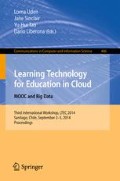Abstract
The Web 2.0 has provided a significant increase in the use of online social networks. In this scenario, Twitter has being used for collaborating, communicating and to exchange ideas between users who share common interests. Consequently, it can be observed an increasing adoption of social networks as a resource to support learning outside the classroom. They can provide mechanisms for sharing ideas and discussions about the studing subjects. However, as far as we know, there is no consensus in the literature whether users indeed efficiently employ these resources for such purpose. An important question is: can the online social networks be used as an efficient learning tool? Helping us to find the answer, this paper presents empirical results of an experiment performed to evaluate the effectiveness of Twitter for supporting learning and also to identify the common behavior of its users.
Access this chapter
Tax calculation will be finalised at checkout
Purchases are for personal use only
Preview
Unable to display preview. Download preview PDF.
References
Maulik, U., Bandyopadhyay, S., Mukhopadhyay, A.: Data Mining Fundamentals - Multiobjective Genetic Algorithms for Clustering, pp. 51–70 (2011)
Benevenuto, F., Rodrigues, T., Cha, M., Almeida, V.: Characterizing User Navigation and Interactions in Online Social Networks. Elsevier Information Sciences 195(15), 1–24 (2012)
Nielsen Online. Social networks & blogs now 4th most popular online activity, ahead of personal email, http://www.nielsen-online.com/pr/pr_090309.pdf (accessed in January 20, 2012)
Cha, M., Benevenuto, F., Haddadi, H., Gummadi, K.: The world of connections and information flow in Twitter. IEEE Transactions on Systems, Man and Cybernetics - Part A 42(4), 991–998 (2012)
Zaina, L.A.M., Bressan, G., Ruggiero, W.V.: Learning Management System of Tidia-Ae Project. In: Proceedings of the 9th IASTED International Conference on Computers and Advanced Technology in Education (2006)
Dabbagh, N., Reo, R.: Back to the future: tracing the roots and learning affordances of social software. In: Lee, M.J.W., McLoughlin, C. (eds.) Web 2.0-Based e-Learning: Applying Social Informatics for Tertiary Teaching (2011)
Stevens, V.: Trial by Twitter: The Rise and Slide of the Year’s Most Viral Microblogging Platform. TESLEJ: teaching english as a second or foreign language, V. 12, N. 1 (2009), http://tesl-ej.org/ej45/int.html (accessed in: February 1, 2012)
Cormode, G., Krishnamurthy, B., Willinger, W.: A Manifesto for Modeling and Measurement in Social Media. First Monday 15(9) (Online) (2010), http://firstmonday.org/htbin/cgiwrap/bin/ojs/index.php/fm/article/view/3072 (accessed in: October 19, 2012)
API TWITTER, http://dev.twitter.com/doc (accessed in: March 1, 2012)
API LONGURL, http://api.longurl.org/v2/expand (accessed in: April 1, 2012)
Dunlap, J.C., Lowenthal, P.R.: Tweeting the night away: Using Twitter to enhance social presence. Journal of Information Systems Education 20(2), 129–136 (2009)
Borau, K., Ullrich, C., Feng, J., Shen, R.: Microblogging for Language Learning: Using Twitter to Train Communicative and Cultural Competence. In: Spaniol, M., Li, Q., Klamma, R., Lau, R.W.H. (eds.) ICWL 2009. LNCS, vol. 5686, pp. 78–87. Springer, Heidelberg (2009)
Cheong, M., Lee, V.: Integrating web-based intelligence retrieval and decision-making from the Twitter trends knowledge base. In: Proceedings of The 2nd ACM Workshop on Social Web Search and Mining (SWSM 2009) (2009)
Vieweg, S., et al.: Microblogging during two natural hazards events: what twitter contribute to situational awareness. In: Proceedings of the 28th International Conference on Human Factors in Computing Systems (CHI 2010) (2010)
Almeida, T.A., Yamakami, A.: Facing the Spammers: A Very Effective Approach to Avoid Junk E-mails. Expert Systems with Applications 39(7), 6557–6561 (2012)
TWITTER, https://twitter.com/ (acessed in: February 1, 2012)
Kohonen, T.: Self-Organizing Maps. 3a. edição (2001)
VISCOVERY SOMine, http://www.viscovery.net/somine/ (acessed in: Apri 20, 2012)
O’Reilly, T.: What is Web 2.0: Design patterns and business models for the next generation of software (2010), http://oreilly.com/web2/archive/what-is-web-20.html (accessed in: October 16, 2010)
Nielsen Online, 2013th edn. Social media report 2012: social media comes of age (2012), http://www.nielsen.com/us/en/newswire/2012/social-media-report-2012-social-media-comes-of-age.html (accessed in: July 2, 2013)
Author information
Authors and Affiliations
Editor information
Editors and Affiliations
Rights and permissions
Copyright information
© 2014 Springer International Publishing Switzerland
About this paper
Cite this paper
Zaina, L.A.M., Ameida, T.A., Torres, G.M. (2014). Can the Online Social Networks Be Used as a Learning Tool? A Case Study in Twitter. In: Uden, L., Sinclair, J., Tao, YH., Liberona, D. (eds) Learning Technology for Education in Cloud. MOOC and Big Data. LTEC 2014. Communications in Computer and Information Science, vol 446. Springer, Cham. https://doi.org/10.1007/978-3-319-10671-7_11
Download citation
DOI: https://doi.org/10.1007/978-3-319-10671-7_11
Publisher Name: Springer, Cham
Print ISBN: 978-3-319-10670-0
Online ISBN: 978-3-319-10671-7
eBook Packages: Computer ScienceComputer Science (R0)

